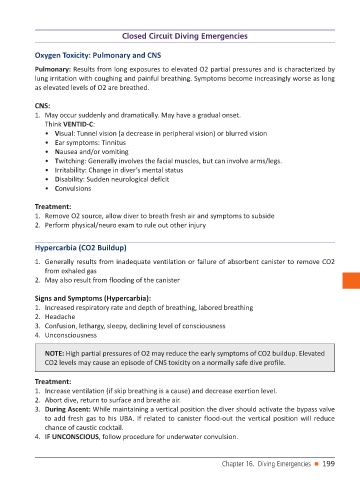Page 201 - PJ MED OPS Handbook 8th Ed
P. 201
Closed Circuit Diving Emergencies
Oxygen Toxicity: Pulmonary and CNS
Pulmonary: Results from long exposures to elevated O2 partial pressures and is characterized by
lung irritation with coughing and painful breathing. Symptoms become increasingly worse as long
as elevated levels of O2 are breathed.
CNS:
1. May occur suddenly and dramatically. May have a gradual onset.
Think VENTID-C:
• Visual: Tunnel vision (a decrease in peripheral vision) or blurred vision
• Ear symptoms: Tinnitus
• Nausea and/or vomiting
• Twitching: Generally involves the facial muscles, but can involve arms/legs.
• Irritability: Change in diver’s mental status
• Disability: Sudden neurological deficit
• Convulsions
Treatment:
1. Remove O2 source, allow diver to breath fresh air and symptoms to subside
2. Perform physical/neuro exam to rule out other injury
Hypercarbia (CO2 Buildup)
1. Generally results from inadequate ventilation or failure of absorbent canister to remove CO2
from exhaled gas
2. May also result from flooding of the canister
Signs and Symptoms (Hypercarbia):
1. Increased respiratory rate and depth of breathing, labored breathing
2. Headache
3. Confusion, lethargy, sleepy, declining level of consciousness
4. Unconsciousness
NOTE: High partial pressures of O2 may reduce the early symptoms of CO2 buildup. Elevated
CO2 levels may cause an episode of CNS toxicity on a normally safe dive profile.
Treatment:
1. Increase ventilation (if skip breathing is a cause) and decrease exertion level.
2. Abort dive, return to surface and breathe air.
3. During Ascent: While maintaining a vertical position the diver should activate the bypass valve
to add fresh gas to his UBA. If related to canister flood-out the vertical position will reduce
chance of caustic cocktail.
4. IF UNCONSCIOUS, follow procedure for underwater convulsion.
Chapter 16. Diving Emergencies n 199

